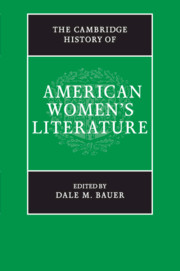Book contents
- Frontmatter
- Contents
- List of illustrations
- Acknowledgements
- Notes on contributors
- Introduction
- 1 The stories we tell: American Indian women's writing and the persistence of tradition
- 2 Women writers and war
- 3 American women's writing in the colonial period
- 4 Religion, sensibility, and sympathy
- 5 Women's writing of the Revolutionary era
- 6 Women writers and the early US novel
- 7 Women in literary culture during the long nineteenth century
- 8 Moral authority as literary property in mid-nineteenth-century print culture
- 9 The shape of Catharine Sedgwick's career
- 10 Writing, authorship, and genius: literary women and modes of literary production
- 11 Nineteenth-century American women's poetry: past and prospects
- 12 Transatlantic sympathies and nineteenth-century women's writing
- 13 Nineteenth-century African American women writers
- 14 Local knowledge and women's regional writing
- 15 Women and children first: female writers of American children's literature
- 16 US suffrage literature
- 17 American women playwrights
- 18 Turn-of-the-twentieth-century transitions: women on the edge of tomorrow
- 19 Accidents, agency, and American literary naturalism
- 20 The geography of ladyhood: racializing the novel of manners
- 21 Self-made women: novelists of the 1920s
- 22 Recovering the legacy of Zara Wright and the twentieth-century black woman writer
- 23 Jewish American women writers
- 24 Women on the breadlines
- 25 Modern domestic realism in America, 1950–1970
- 26 Lyric, gender, and subjectivity in modern and contemporary women's poetry
- 27 Contemporary American women's writing: women and violence
- 28 Asian American women's literature and the promise of committed art
- 29 Straight sex, queer text: American women novelists
- 30 Latina writers and the usable past
- 31 Where is she? Women/access/rhetoric
- 32 Reading women in America
- Index
- References
24 - Women on the breadlines
Published online by Cambridge University Press: 28 September 2012
- Frontmatter
- Contents
- List of illustrations
- Acknowledgements
- Notes on contributors
- Introduction
- 1 The stories we tell: American Indian women's writing and the persistence of tradition
- 2 Women writers and war
- 3 American women's writing in the colonial period
- 4 Religion, sensibility, and sympathy
- 5 Women's writing of the Revolutionary era
- 6 Women writers and the early US novel
- 7 Women in literary culture during the long nineteenth century
- 8 Moral authority as literary property in mid-nineteenth-century print culture
- 9 The shape of Catharine Sedgwick's career
- 10 Writing, authorship, and genius: literary women and modes of literary production
- 11 Nineteenth-century American women's poetry: past and prospects
- 12 Transatlantic sympathies and nineteenth-century women's writing
- 13 Nineteenth-century African American women writers
- 14 Local knowledge and women's regional writing
- 15 Women and children first: female writers of American children's literature
- 16 US suffrage literature
- 17 American women playwrights
- 18 Turn-of-the-twentieth-century transitions: women on the edge of tomorrow
- 19 Accidents, agency, and American literary naturalism
- 20 The geography of ladyhood: racializing the novel of manners
- 21 Self-made women: novelists of the 1920s
- 22 Recovering the legacy of Zara Wright and the twentieth-century black woman writer
- 23 Jewish American women writers
- 24 Women on the breadlines
- 25 Modern domestic realism in America, 1950–1970
- 26 Lyric, gender, and subjectivity in modern and contemporary women's poetry
- 27 Contemporary American women's writing: women and violence
- 28 Asian American women's literature and the promise of committed art
- 29 Straight sex, queer text: American women novelists
- 30 Latina writers and the usable past
- 31 Where is she? Women/access/rhetoric
- 32 Reading women in America
- Index
- References
Summary
The proletarian and radical literature written during the Great Depression has had a famously doomed afterlife. For decades, when it was not being attacked, it was being ignored. The New Critics defined themselves – and the canon of American literature – against it, and Cold War-era English Departments did their best to pretend that it never happened. From the late 1940s to the late 1970s, you can count on two hands the number of scholarly books devoted to radical and proletarian writers of the 1930s. Moreover, when scholars did brave the critical climate, their writing focused almost exclusively on men. True, some women writers from the period – Josephine Herbst, Genevieve Taggard – simply played too big a role in radical literary culture to drop out of the story completely. But in the early literary histories of the movement – Walter Rideout's The Radical Novel in the United States 1900–1954 (1956), Daniel Aaron's Writers on the Left (1961), or Richard Pell's Radical Visions and American Dreams (1977) – and the first attempts at constructing a canon of radical and proletarian literature of the 1930s, women remained decidedly in the background.
This essay, following the work of a number of scholars in the last two or three decades, tries to bring those women writers of the 1930s into the foreground. In defense of these early critics, though, one should note that they may not have actively – or even perhaps consciously – written women out of literary history, but, rather, simply responded to the fact that something about the decade itself seemed peculiarly masculine. From certain if not most perspectives, that is, the victims of the Great Depression, as well as their chroniclers, seemed to be mostly men. Unsurprisingly, then, men dominated the histories they told.
- Type
- Chapter
- Information
- The Cambridge History of American Women's Literature , pp. 477 - 500Publisher: Cambridge University PressPrint publication year: 2012



